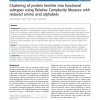167 search results - page 10 / 34 » The accuracy of several multiple sequence alignment programs... |
GECCO
2004
Springer
14 years 28 days ago
2004
Springer
Aligning multiple DNA or protein sequences is a fundamental step in the analyses of phylogeny, homology and molecular structure. Heuristic algorithms are applied because optimal mu...
TCBB
2008
13 years 7 months ago
2008
When aligning biological sequences, the choice of scoring scheme is critical. Even small changes in gap penalties, for example, can yield radically different alignments. A rigorous...
BMCBI
2010
13 years 7 months ago
2010
Background: Phylogenetic analysis can be used to divide a protein family into subfamilies in the absence of experimental information. Most phylogenetic analysis methods utilize mu...
RECOMB
1997
Springer
13 years 11 months ago
1997
Springer
A progressive alignment algorithm produces a multi-alignment of a set of sequences by repeatedly aligning pairs of sequences and/or previously generated alignments. We describe a ...
BMCBI
2010
13 years 7 months ago
2010
Background: Determining beforehand specific positions to align (anchor points) has proved valuable for the accuracy of automated multiple sequence alignment (MSA) software. This f...

